

USGS scientist takes aim at Great Lakes invaders
Rising Higher: A Research Lab Built from the Ground Up - Part 2
Great Lakes Researchers Go Down Under
Rising Higher: A Research Lab Built from the Ground Up - Part 1
A Monograph on Ciscoes of the Laurentian Great Lakes and Lake Nipigon
WATCH: Acoustic Telemetry Provides In-Depth Look into Fish Behavior
Eel-Ladder Style Traps: A New Lamprey Control Tool
A Lampricide Treatment: Up-Close
Lamprey Nativeness Claims Annulled by Commission's Eshenroder
A Population at the Edge: American Eel Declining at the Extremes
Celebrating 60 Years of Successful Sea Lamprey Control, Science, and Cross-Border Collaboration!
Great Lakes Scientists Use Acoustic Telemetry to Reveal the Secret Lives of Fish
Hammond Bay Biological Station: The Nexus for Research and Restoration on the Great Lakes
Big Consequences of Small Invaders
New Sea Lamprey Estimates Suggest a Dramatically Decreased Population
Conducting Research through Cooperative Partnerships: The PERM Agreement
Living on the Edge: A Closer Look at Coastal Communities
Asian Carp: The War Isn't Over
Managing the Lake Huron Fishery
Understanding Sea Lamprey: Mapping the Genome and Identifying Pheromones
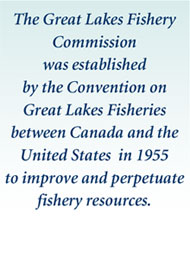
- A Monograph on Ciscoes of the Laurentian Great Lakes and Lake Nipigon
- Meet the Fleet: GLFC-USGS Partnership Makes Waves with Newly Renovated Deepwater Science Vessel Fleet
- Rising Higher: A Research Lab Built from the Ground Up. Part 1.
- Great Lakes Researchers Go Down Under
- Rising Higher: A Research Lab Built from the Ground Up. Part 2.
- UWL grad, USGS scientist takes aim at Great Lakes invaders
USGS Scientist Takes Aim at Great Lakes Invaders
- Story by University Communications, University of Wisconsin-La Crosse
Sea lamprey have a nasty bite. This blood-sucking parasite could kill more than 100 million pounds of Great Lakes fish annually if left unchecked, according to the Great Lakes Fishery Commission.
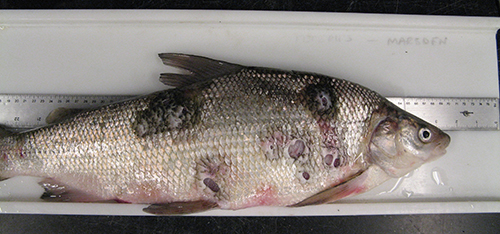
"If we didn’t have controls, we wouldn’t have a fishery to speak of—recreational, commercial or tribal," says Marc Gaden, communications director for the Great Lakes Fishery Commission. "Beyond that effect, they would destroy the ecosystem from the top down."
Nick Schloesser, a recent University of Wisconsin-La Crosse graduate who is also a U.S. Geological Survey biologist, is adding to the body of knowledge to protect the world’s largest collective body of fresh water from the bitter bite of the lamprey. He shared his finds related to using Environmental DNA monitoring to help control populations of lamprey in December as part of his UWL master’s thesis project.
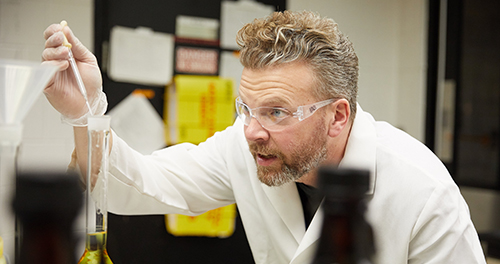
"This (eDNA monitoring) is certainly state-of-the-art and something the fishery commission is interested in," says Gaden. It could save money and time in assessing streams and rivers to determine where to control lamprey, he adds.
Schloesser's research opportunity and student-scientist status came about because of a long-term cooperative educational agreement between UWL and USGS Upper Midwest Environmental Sciences Center, located on French Island.
Sea lamprey’s bitter bite
The sea lamprey, an invasive species, entered the Great Lakes in the early 1920s. Its toll was so high on specific species of fish that, by the late 1950s, it was a major factor in the collapse of the Great Lakes fishery. Since then, the U.S. and Canada have partnered to find solutions, forming the Great Lakes Fishery Commission in 1955. Today the commission reports successfully reducing the sea lamprey population by 90 percent in most areas of the Great Lakes. Yet control requires constant tweaking, says Randy Hines, U.S. Geological Survey wildlife biologist.
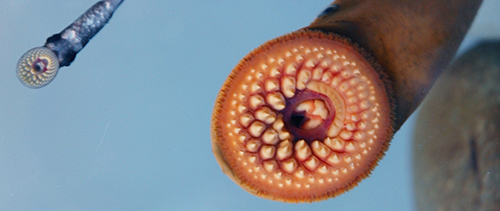
Wildlife managers have used many techniques to control sea lamprey from toxic chemicals to barrier dams. However, lamprey are still an economic and ecological concern that costs millions of dollars to fisheries every year in loss of large Great Lakes fish and eradication efforts. Wisely spending budget dollars on eradication depends largely on aiming these controls effectively.
Improving lamprey control
Schloesser's master's project leveraged his experience as a UWL graduate research student with experience working at USGS. His graduate thesis project aimed to provide more guidance in determining the location of sea lampreys to save budgets and time.
To control sea lamprey, Canadian and U.S. Fish and Wildlife Service biologists begin by assessing tributaries to determine which ones contain larval sea lampreys. Lamprey are constantly sloughing off cells from their bodies, leaving remnants of DNA—called Environmental DNA—in river or stream sediment, says Schloesser. Through his UWL research, he found Environmental DNA monitoring could potentially be one more tool to determine the concentration of lamprey in a particular stream.
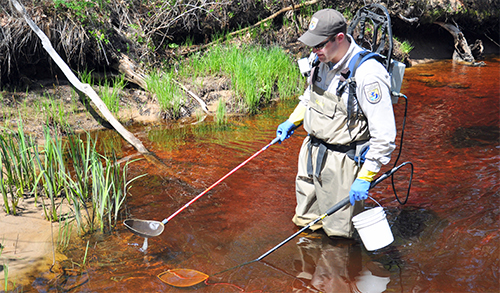
Schloesser's finds could save time, money and effort as the typical method for monitoring sea lamprey is physical monitoring, says Hines. "eDNA allows for that rapid screening—doing more waters, more efficiently," says Hines. "It definitely serves a big need from a national and international perspective."
Research project spawned from partnership
Nick Schloesser's research project is a product of UWL's long-term Cooperative Educational Agreement with the USGS Upper Midwest Environmental Sciences Center. A partnership between USGS and UWL's River Studies Center started back in the 1970s, allowing UWL students to conduct research with USGS scientists focused primarily on river science and fish health. Today the partnership encompasses a variety of UWL disciplines.
Hines says the collaboration brings strength to their team of scientists through professional interactions with UWL faculty. It also helps them attract talent as many of UWL's undergraduate and graduate students transition into full-time work at USGS.



